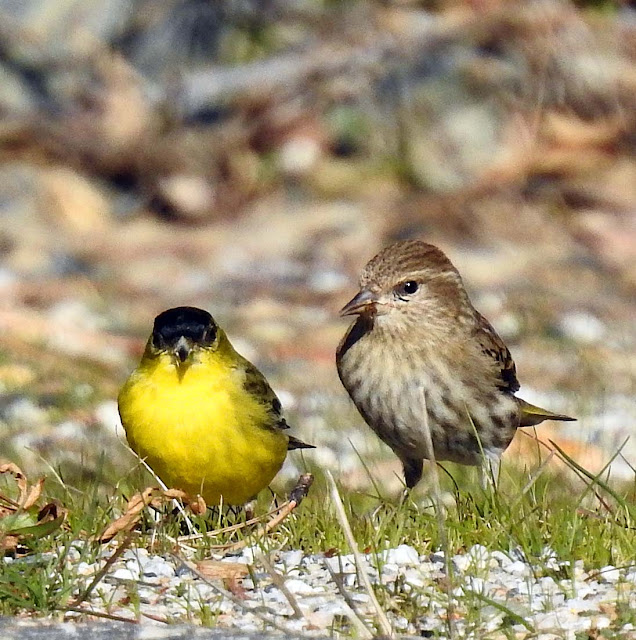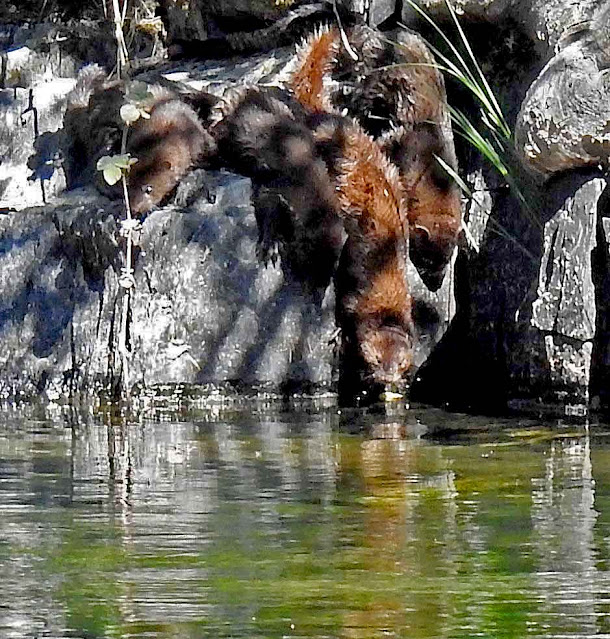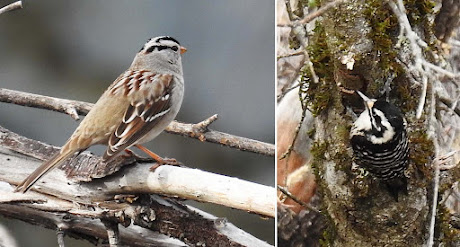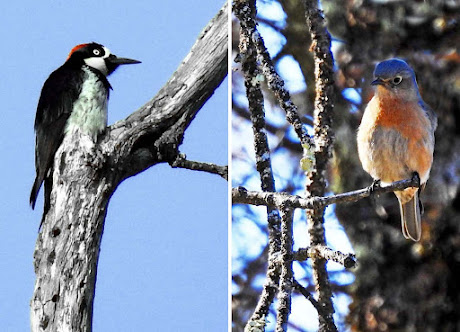Steller's Jay (adult) - Cyanocitta stelleri
In the last forty-eight hours, 24" of powder snow has fallen in our neighborhood!!! A lot of the time it was falling, it was a whiteout blizzard! Roads closed due to the heavy snow, and many places experienced power outages. Luckily we didn't have to go anywhere, so we stayed home, went for walks in the snow, and fed the local birds!
To our delight a few avian surprises showed up in our backyard!
Varied Thrush (male - female) - Ixoreus naevius
It has been several years since a Varied Thrush has showed up in our area, but winter is when I usually see them. I have always only seen one pair of them in our neighborhood at a time, and this year was no exception! Yesterday, a male and a female showed up in the heavily falling snow and started feeding on the bird seed I had scattered on the ground! They were there again this morning! The male is more darkly marked than the female. They are both just beautiful!
Varied Thrushes have irruptive winter behavior, which means they don't stay in one area all winter if the food supply is low. Rather they will travel to find food, often for quite a distance. These birds breed and raise their young in western Canada and into Alaska. In the winter they often live on the Pacific Coast from southern Alaska to southern California, and/or in the central valley of California. Their main winter foods are seeds, nuts (acorns), berries, and fruits.
I have no idea why they show up in our neighborhood! Maybe they just go exploring and one seed leads to another!
Red-winged Blackbird (male) - Agelaius phoeniceus
Another surprise was this single Red-winged Blackbird that showed up in our backyard late yesterday afternoon! These birds don't usually come here in the winter, nor do they nest here. I have seen a few pass through in the early Spring, but never in the winter before. My neighbor has a small cattail rimmed pond where some Red-wings visit in the spring. Perhaps the warm weather that preceded this storm lured him up here!
Today we are having a break in the weather and it's not snowing. More heavy snow is predicted to start again tomorrow, and continue through Wednesday. Hopefully, this little beauty will head back down to the foothills today!
North Yuba River - 2/24/23
I walked down to the river every morning to see what was happening! It was so blizzardy that I couldn't really keep my camera out for any length of time, without it getting too wet. Just when I got to the middle of the bridge, some waterfowl landed in the river below it!
Common Goldeneyes (3 females - 1 male) - Bucephala clangula
These Common Goldeneyes didn't seem bothered by the blizzard conditions and just carried on with their usual behavior of diving for food.
Common Mergansers (female - male) - Mergus merganser
There were also a pair of Common Mergansers on the river! This was the first male Merganser I've seen this winter! I have seen three female Mergansers on the river for months, but this male must have just joined them!
Pipevine - Aristolochia californica
Before the Storm!
Just a few days before the storm hit, we hiked down in the South Yuba River State Park to see if any wildflowers were blooming. To our delight there was a scattering of a variety of wildflowers in bloom! This cold weather has probably curbed any further blossoming, but the moisture from the storm is a gift!
We were delighted to find some Pipevine in bloom! They are such unique beautiful blossoms! The Pipevine or Dutchman's Pipes is one of the earliest blooming native wildflowers. We were lucky to find many of the flowers, being green and brown in color they are somewhat hard to detect! These plants are not carnivorous, but they have an odor that attracts carrion-feeding insects that crawl inside the pipe-shaped flower and pollinate the blossom! Amazing!
We didn't see any Pipevine Swallowtail Butterflies on our hike. They overwinter in a chrysalis, and perhaps they haven't emerged yet. Maybe we'll see them the next time we visit the park. In the spring, Pipevine Swallowtail Butterflies mate, the female lays her eggs (which contain toxic acids) on the underside of Pipevine leaves. When the caterpillars first hatch, they stay together in small groups and feed on Pipevine leaves. When they grow larger they head out on their own to feed and pupate. It takes approximately one week for a caterpillar to change into an adult and emerge from its chrysalis. The adults usually live for a month, feeding solely on wildflower nectar.
Blue Dicks - Red Maids - Common Fiddleheads
Dichelostemma capitatum - Calandrinia menziesii - Amsinckia intermedia
Bald Eagle (adult) - Haliaeetus leucocephalus
To our complete surprise we heard and then saw a Bald Eagle perched above the South Yuba River!!! These eagles are known to nest in the park! Perhaps this one was calling for its mate!
Manroot - Lacepod - Canyon Nemophila
Marah fabacea - Thysanocarpus curvipes - Nemophila heterophylla
South Yuba River State Park - Ground Iris - Iris macrosiphon
The trees hadn't leafed out yet, but new green grasses were covering the hillsides! It was a joy to see the beginnings of spring. We'll have to go back soon!
Weather Update
This week, the two feet of powder snow that fell contained 1.75" of water. This brings our water year total up to 55.16"!!! A lot more cold snow is coming over the next 4 days! We need all the moisture we can get, so I am grateful for these winter storms!
What's happening in the foothills and Central Valley?
How much snow did the Lakes Basin get?
Check back next week for the answers to these questions and more!
Unfortunately, you can no longer sign up to get my blog via email. Just go to northyubanaturalist.blogspot.com directly.
Your questions and comments are greatly appreciated. Please feel free to email me at northyubanaturalist@gmail.com. Thanks!




































.jpg)








altered.jpg)








